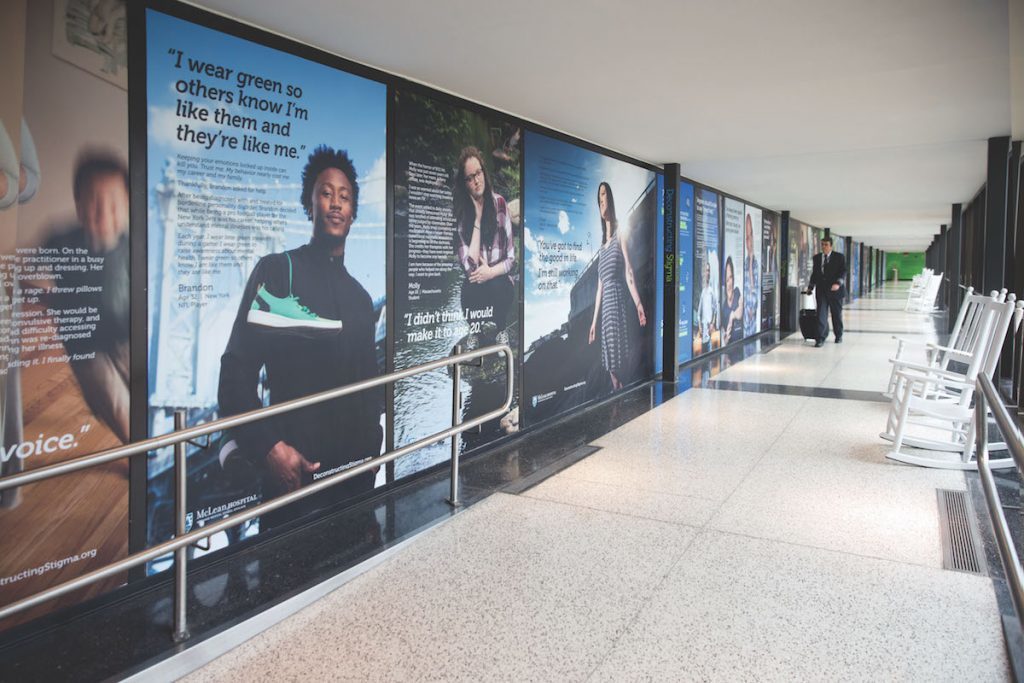How One Organization Is Deconstructing the Stigma Around Mental Illness, One Story at a Time
// By Lisa D. Ellis //
If you’re traveling through Logan Airport in Boston anytime soon, you’ll probably be drawn to a collection of portraits, and accompanying personal stories, lining the walls between terminals. You’ll see beautiful, larger-than-life portraits of: Teens. Single men and women. Parents. Grandparents. Athletes. Lawyers. Physicians. Musicians. An author. A former soap opera star. Some have light hair, some have dark hair, others have no hair at all. They range in age from 15 to 76.

Regardless of the differences, one common thread connects them all: They all are affected by mental illness. Depression, anxiety, OCD, eating disorders, substance abuse, and trauma are some of the diagnoses the people in the portraits live with. They also have the courage to share their stories in this very public setting.

Adriana Bobinchock, senior director of public affairs and communications at McLean Hospital
Deconstructing Stigma, One Photo at a Time
This photo installation is part of a campaign called “Deconstructing Stigma: A Change in Thought Can Lead to a Change in Life” launched in 2016 by McLean Hospital in Belmont, Massachusetts. This effort, recognized in the 2017 eHealthcare Leadership Awards, started simply but has grown and evolved in recent months, taking on a breadth and depth that the McLean staff could not have anticipated, according to Adriana Bobinchock, McLean’s senior director of public affairs and communications.
McLean’s Commitment to Raising Public Awareness About Mental Illness
As an affiliate of Harvard Medical School, McLean has earned a reputation as a leading behavioral health care provider in New England, as well as serving people around the country, with an array of residential, inpatient, and ambulatory programs.
“McLean’s mission elements are clinical care, research, and education,” Bobinchock explains. “A few years ago, the hospital leadership recognized that it wanted to do more in the realm of public awareness to help fight back against the stigma that exists around mental illness.”
The Campaign Is Born
 “Back then we knew we wanted to create a very large, in-your-face campaign, but we didn’t know what it would look like,” she recalls.
“Back then we knew we wanted to create a very large, in-your-face campaign, but we didn’t know what it would look like,” she recalls.
A chance encounter at an art installation featuring photographs of the faces and stories of prisoners sparked Bobinchock and campaign co-founder Scott O’Brien to come up with the idea for the Deconstructing Stigma campaign.
After getting approval for the idea from the administration, Bobinchock emailed McLean staff, looking for patients who might be willing to share their stories with the general public. She also posted an open call on Facebook. The hope was to find 12 people affected by mental illness whom they could spotlight.
Within just 24 hours, more than 100 people had responded, Bobinchock says.
After vetting each one, ultimately the list was narrowed down to about 60 participants. About half of them were already familiar with McLean at the onset, while the other half had never accessed services through this provider. But all of them wanted to help others by coming out publicly to talk about their struggles.
Working with Participants
“We worked with clinical advisors to be sure we were doing the right thing,” she emphasizes.
“We kept saying to each person, ‘Are you sure you want to do this? You’ll have an eight-foot-tall photo in a very public place.’” She says most of the people they spoke with shared that they had felt intensely alone and scared at some point in the past. Standing up and putting themselves out there was a way to try to prevent other people from having to feel the same way.
“The biggest challenge we faced was with all of the time and manpower involved to try to manage this and to tell each patient’s story,” she admits. “The experience was also a lot more emotional for my team than we expected,” she says.
She also says that they talked a lot with participants about what it would mean to be out there so visibly. “With Google, this would never go away, so people had to be prepared for what they were getting into,” she says.
Capturing Life Experiences
It was important to the McLean team running this project, which consisted of just Bobinchock and two colleagues, that each participant have a chance to tell his or her own story in their own words.
“We also worked with a graphic designer, photographer, and freelance writer. For my small team, this was truly a labor of love,” she says. “We wanted to act as the conduit to bring all of these stories in their own words to the public.” In some cases, it took 10 or 15 drafts to get the story just right. But this drive for perfection was well worth it, she adds.
Celebrities Opt In
At the last minute, Bobinchock says they also decided to open the project up to celebrities, sending out emails to a variety of well-known figures without any expectations. They were stunned when the replies started pouring back in. Former soap opera star and singer Rick Springfield, actor/comedian Howie Mandel, rapper Darryl “DMC” McDaniels of Run-DMC, and best-selling author Anne Rice are among the best-known people to take part in this project.
Despite the large scale of the project, it was all done without any designated budget—none of the celebrities ever asked for compensation or expected to be treated differently than any of the other participants.
“We did get some philanthropic support and the vendors all also agreed to lower their rates for this project,” she says.
Partnering with Logan Airport
When they were exploring where the exhibit could be housed, Logan Airport stepped forward and offered to fill that role. An estimated 1 million travelers pass the area where the exhibit is, making a perfect spot to reach a widespread audience.
Despite tight airport security restrictions, the placement of the installation was also easy and painless, Bobinchock says.
“Most of the installation work happened overnight when there was less foot traffic,” Bobinchock says, adding that the Logan Airport staff was amazing in making things go seamlessly.
From start to finish, the campaign took the better part of a year to complete before it could be installed in the airport hallway.

Momentum Increases
The exhibit officially launched in 2017 and has continued to grow since then. One viewer took a photo of the exhibit at Logan and sent it to his niece, who had just attempted suicide. The niece was so moved by the project she decided to run the Boston Marathon in honor of the campaign. She raised $27,000 in pledges. She also agreed to be included in the next round of portraits for the campaign, currently underway.
In addition, Bobinchock points out that they have heard from a steady stream of people who want to be included in the next batch of photographs, which are expected to be put up later this year. And the interest in the campaign shows no signs of dying down anytime soon.
Campaign Adapts and Expands
The campaign model has grown beyond its original scope. Bobinchock says they now work on a Deconstructing Stigma campaign focused on communities of color. They are also working with a nonprofit organization that plans to take the campaign to Ghana, West Africa. Additional campaigns are being considered for locations throughout the U.S. and in other nations, as well.
“We can scale this model large or small to be in different places,” she says.
Regardless of a specific exhibit’s location or focus, she says the goal remains consistent: to combat stigma and to remind people suffering a form of discrimination that they are not alone.
To learn more about the campaign and to find out how you can participate, go to www.deconstructingstigma.org.
Lisa D. Ellis is a contributing writer for Strategic Health Care Marketing. She is a journalist and content development specialist who helps hospitals and other health care providers and organizations shape strategic messages and communicate them to their target audiences. You can reach her at lisa.ellis@strategicHCmarketing.com.
